Pxx+1x 2 X 1 2 Verify Whether The Following Are Zeroes Of The Polynomial
Use factor theorem to find whether polynomial g(x) is a factor of polynomial f(x) or, not:.
Pxx+1x 2 x 1 2 verify whether the following are zeroes of the polynomial. `f(x)=x^2- 1,x=1,-1` VIEW SOLUTION. Verify whether the indicated numbers is zeroes of the polynomials corresponding to them in the following case:. By actual division, find the quotient and the remainder when the first polynomial is divided by the second polynomial:.
1 Let us test. Check whether polynomial p(x) = 2x(cube) - 9x(square) + x + 12 is a multiple of 2x-3 or not. Put Divisor = 0 x + 1 = 0 x = –1 Step 2:.
(i) p(y)=y2−y+1 (ii) p(t)=2+t+2t2−t3 (iii) p(x)=x3 (iv) p(x)=(x−1)(x+1) Q3. Asked Jan 5, 18 in Class X Maths by priya12 ( -12,631 points). Ex 2.2, 3 Verify whether the following are zeroes of the polynomial, indicated against them.
F(2) = 2(2) 3 −(2) 2 −7(2)+2 = 16−4−14+2 = 0. Since all of the variables have integer exponents that are positive this is a polynomial. Download free PDF of best NCERT Solutions , Class 9, Math, CBSE- Polynomials.
3x 4 + 6x 3. P(x)= x 2 +5x+6 is a quadratic polynomial. 3.3 Find roots (zeroes) of :.
The remainder is not zero. (x 7 + 2x 4 - 5) * 3x:. Using the definition, determine whether the function \(f(x)=\begin{cases}2x+1, & \text{if }x<1\\2, & \text{if }x=1\\ −x+4, & \text{if }x>1\end{cases}\) is continuous at \(x=1\).
Ex 2.4, 2 Use the Factor Theorem to determine whether g(x) is a factor of p(x) in the following cases:. 2) Use a graphing utility to graph the function and determine the x-intercepts and B. Find the factors of 2x 3 −x 2 −7x+2.
Give the domain of the function and identify any vertical or horizontal asymptotes. Get FREE NCERT Solutions for Class 9 Maths Chapter 2 Polynomials Exercise 2.2. (i) p(x) = 3x + 1, x = – 1/3 Given p(x) = 3x + 1 Putting x = – 1/3 p((−1)/3) = 3 ((−1)/3) + 1 = -1 + 1 = 0 Since p((−1)/3) is equal to 0 Therefore, x = (−1)/3 is a zero of the given polynomial.
Students can solve NCERT Class 10 Maths Polynomials MCQs with Answers to know their preparation level. State reasons for your answer. X^3+6x^2+11x+6=color(red)((x+1)(x+2)(x+3)) There are several ways to approach this.
In the context of the Remainder Theorem, this means that my remainder, when dividing by x = 2, must be zero:. That's because adding zero is the same as subtracting zero. Describe the end behavior of each function.
Then express f(x) = 2 + 3x - x^2 as a linear combination. Hope it helps !!. Therefore, for x = −5, the value of the polynomial is 0 and hence, x = −5 is a zero of the given polynomial.
Detailed solution for all NCERT exercise questions and video explanations for the more difficult questions. To find zeroes, let p(x)=0 (x+2)(x+3) =0 x=-2 or x=-3 ∴The zeroes of the. Prove that { 1 , 1 + x , (1 + x)^2 } is a basis for the vector space of polynomials of degree 2 or less.
If the zeroes of the polynomial x 3 – 3x 2 + x + 1 are a – b, a and. P(x) = 2x3 + x2 – 2x – 1 Putting x = –1 p(–1) = 2(−1)3 + (−1)2 – 2(−1) – 1 = 2(–1) + 1 + 2 – 1. (i) p(x) = 3x + 1, x = - 1/3 (ii) p(x) = 5x – π, x = 4/5.
Find the value of the polynomial 5x – 4x 2 + 3 at (i) x=0. Chapter 2 Ex.2.2 Question 3. Verify whether the following are zeroes of the polynomial, indicated against them.
P(x)= (x+2)(x+3) is a quadratic polynomial. The graph of f(x)=ax^2+bx+c can have either no x-intercepts or two x-intercepts but never just one x-intercept. N is an odd integer.
The axis of symmetry has the form x=h where h is the x-coordinate of the vertex. We can check easily:. Verify whether the following are zeroes of the polynomial, indicated against them.
The quotient is x 3 + x 2 + x + 1 and the remainder is 2. (i) 4x 2 - 3x + 7. F(2)=0, so we have found a root and a factor.
Verify whether the following are zeroes of the polynomial, indicated against them. In this case, the Rational Root Theorem tells us that (if the expression has rational roots) those roots are integer factors of 6 (the constant term of the expression). X 2 + 2x +5:.
There is only one variable x with whole number power. Here, the number that multiplies the variable x 2 is -1. If the zero of the polynomial x 2 − p x + q are doubled in value to the zeroes of 2 x 2 − 5 x − 3, find the value of p and q.
From the table below, you can notice that sech is not supported, but you can still enter it using the identity `sech(x)=1/cosh(x)`. Give example of polynomials p(x), g(x), q(x) and r(x), which satisfy the division algorithm and. X 4 + 1;.
NCERT Solutions for Class 9 Math. So times some other. P (x) = l x + m, x = − l m View Answer.
Verify whether the following are zeroes of the. To find whether (x+1) is a factor of the following polynomials, first we put x+1 = 0. Therefore, for x = 5, the value of the polynomial is0 and hence, x = 5.
MCQ Questions for Class 10 Maths with Answers was Prepared Based on Latest Exam Pattern. Ex 2.2 Class 9 Maths Question 1. So let's prove using x = 1 first Since the equation turns to be zero, 1 is the zero of the polynomial.
P(x) = (x-a).q(x) where the remainder is said to be zero. - Degree of Monomial 32 2 4 5is 2+4+5= 11 2) Binomial :- An algebraic expression consisting two term is called. One of the most reliable is to hope that the expression has rational roots and apply the Rational Root Theorem.
The curve crosses the x-axis at three points, and one of them might be at 2. Therefore, x = -1 and x = 2 are zeroes of the polynomial p(x) = (x +1) (x – 2). To get `tan(x)sec^3(x)`, use parentheses:.
The polynomial is degree 3, and could be difficult to solve. If the function is not continuous at 1, indicate the condition for continuity at a point that fails to hold. I want to know if its Taylor series centered around that point has a non-zero radius of convergence, and if it does, if the residue term given by Taylor's Theorem goes to zero as n goes to infinity within the radius of.
(i) p(x) = x + 5 p(x) = 0. (x+1) is a factor of x n + 1 only if. Zero of a polynomial is that value of the variable at which the value of the polynomial is obtained as 0.
View Answer The graph of y − p ( x ) is given in the figures below, where p ( x ) is a polynomial. We divide the given polynomial by x 2 – 5 / 3. If you get an error, double-check your expression, add parentheses and multiplication signs where needed, and consult the table below.
Here, p(0) = (0)2 = 0. 1 of the Trailing Constant :. So x-a is said to be the factor of that polynomial p(x).
The zeros of the polynomial p (x) = x (x − 1) (x − 2) are obtained be solving the equation p (x) = 0. Asked Sep 14, 18 in Class IX Maths by navnit40 ( -4,939 points) polynomials. P(x) = 5x^4 - 6x^6 + 3x + 2.
It has at most two zeroes. If α and β are the zeroes of a polynomial x 2 − 4 3 x + 3,. The required divisor g(x) = x 2 – x + 1.
Hence, x = -l/m is a zero of the polynomial p(x) = lx+m. The equation 2–x 2 +x 3 can be written as 2+(–1)x 2 +x 3 We know that, coefficient is the number (along with its sign, i.e., – or +) which multiplies the variable. Since the two zeros are √(5 / 3) and -√(5 / 3)Therefore, x – √(5 / 3)x + √(5 / 3) = (x 2 – 5 / 3) is a factor of 3x 4 + 6x 3 – 2x 2 – 10x -5.Thus.
Find p(0), p(1) and p(2) for each of the following polynomials:. So let us plot it first:. We just have to realize, okay, if x minus five is a factor of p of x, that means you could write p of x, let me do this in that green color, that means you could write p of x as being equal to x minus five times some other business, times some other polynomial.
Class 10 Maths MCQs Chapter 2 Polynomials 1. X = -2 / 2 = -1. Use the Remainder Theorem to determine whether x = –4 is a solution of x 6 + 5x 5 + 5x 4 + 5x 3 + 2x 2 – 10x – 8 = 0.
X 3 +x 2-x-1 Remainder:. Find the zeroes of the following quadratic polynomials and verify the relationship between the zeroes and the coefficients. 1 and 2 are zeros of polynomial means that if the value is substituted for x then the equation turns zero.
Now let's take x = 2 Since the equation turns to be zero, 2 is also the zero of the polynomial. X = - 1 / 2 , x = 2 / 3. In the following , determine whether the given values of x are zeroes of the given polynomial or not 6x2 - x - 2 ;.
We can write it in the form:. P(x) = 2x^3 + x^2 + 3x + 2 2. Here we have given Karnataka Board Class 9 Maths Chapter 4 Polynomials Exercise 4.2.
P(x) = 3x 4 + 6x 3 – 2x 2 – 10x -5. (i) 4x 2 - 3x + 7 (ii) y 2 + √2 (iii) 3√t + t√2 (iv) y + 2/y (v) x 10 + y 3 + t 50. Sum of zeroes =.
We have created Step by Step solutions for Class 9 maths to help you to revise the complete Syllabus and Score More marks. Stack Exchange network consists of 176 Q&A communities including Stack Overflow, the largest, most trusted online community for developers to learn, share their knowledge, and build their careers. Polynomial Roots Calculator :.
Free PDF Download of CBSE Class 10 Maths Chapter 2 Polynomials Multiple Choice Questions with Answers. Find the value of the polynomial `5x-4x^2+3` at (i)`x=0` (ii) `x=-1` (iii) `x=2` Doubtnut के साथ १००% मार्क्स पायें, आज ही डाउनलोड. F(x) = x 3 +x 2-x-1 See theory in step 3.1 In this case, the Leading Coefficient is 1 and the Trailing Constant is -1.
Of the Leading Coefficient :. (x + 1)(x + 2)(x + 3) {/eq} Polynomial function:- A function is described as a polynomial function if the function has one variable and exponents of the variable are positive integers. Verify that 3, –1,-1/3 are the zeroes of the cubic polynomial p(x) = 3x^3 – 5x^2 – 11x – 3, asked Jan 23, 19 in Mathematics by Bhavyak ( 67.3k points) polynomials.
X + 5 = 0. NCERT Solutions for Class 9 Maths Chapter 2 Polynomials Ex 2.2. Since all of the variables have integer exponents that are positive this is a polynomial.
You can also get free sample papers, Notes, Important Questions. Chapter 2 Polynomials Exercise 2.2. All right, so I'm assuming you have attempted this.
All NCERT textbook questions have been solved by our expert teachers. (i) \(\begin{align}p(x)=3 x+1, x = -\frac{1}{3}\end{align}\). Since all of the variables have integer exponents that are positive this is a polynomial.
So,-1 is a zero of p (x) now,if x=2, p (2)=2^2-2-2. F(x)= \frac{1}{1+x^2} /tex is indefinitely derivable at x=1, I want to know if it's analytic at this point or not!. It has at most two zeroes.
Types of polynomials 1) Monomial :- An algebraic expression consisting of only one term is called a Monomial Ex:. Three solutions were found :. X = − 5.
Value of polynomials for different values of variables, verifying whether the given values of variables are zeroes of polynomials, and finding the zeroes of polynomials. X − 5 = 0. Which of the following expressions are polynomials in one variable and which are not?.
Exercise 6.2 | Q 2.3 | Page 8. To find zeroes, Let p(x)=0 x 2 +5x+6=0 (x+2)(x+3)=0 x=-2 or x=-3 ∴The zeroes of the polynomial are -2 and -3. KSEEB Solutions for Class 9 Maths Chapter 4 Polynomials Ex 4.2 are part of KSEEB Solutions for Class 9 Maths.
Obtain all other zeroes of 3x 4 + 6x 3 – 2x 2 – 10x -5, if two of its zeroes are √(5 / 3) and -√(5 / 3) Solution:. Then x = 2 is not a zero of f (x). So,2 is also a zero of p (x) hence verified.
Check here step-by-step solution of 'Verify whether the following are zeroes of the polynomial, indicated against them.' questions at Instasolv!. Free functions calculator - explore function domain, range, intercepts, extreme points and asymptotes step-by-step. (v) If x = 0 is a zero of polynomial p(x) = x2, then p(0) should be zero.
(ii) p(x) = x − 5 p(x) = 0. Hence, x = 0 is a zero of the polynomial p(x) = x² (vi) p(-l/m) = l(-l/m) + m. This theorem also shows us the relationship between factors of the polynomials as well as zero of polynomial and helps to find out the zero of a polynomial having two or higher degrees.
Thus x = -1 Now, we will put x = -1 in each of the polynomials and for those polynomials which become x zero have (x+1) as the factor. 7, 7 2and 32 2 4 5 Note:. The value of is zero when x – 4 = 0 or x + 2 = 0, i.e., when x = 4 or x = – 2 Therefore, the zeroes of are 4 and – 2.
X = ————— 2 The square root of zero is zero This quadratic equation has one solution only. By Remainder Theorem find the remainder, when p(x) is divided by g(x), where (i) p(𝑥) = 𝑥 3 – 2𝑥 2 – 4𝑥 – 1, g. Find the zeroes of the following quadratic polynomials and verify the relationship between the zeroes and the coefficients.
(i) p(x) = 2x3 + x2 – 2x – 1 , g(x) = x + 1 Finding remainder when 2x3 + x2 – 2x – 1 is divided by x + 1 Step 1:.

Example 3 Check Whether 2 And 2 Are Zeroes Of The Examples

Ex 2 4 2 Use The Factor Theorem To Determine Whether Ex 2 4

Example 5 Optional Verify 3 1 1 3 Are Zero Of Cubic Polynomial
Pxx+1x 2 X 1 2 Verify Whether The Following Are Zeroes Of The Polynomial のギャラリー
Cbse 9 Math Cbse Polynomials Ncert Solutions

Polynomial Functions
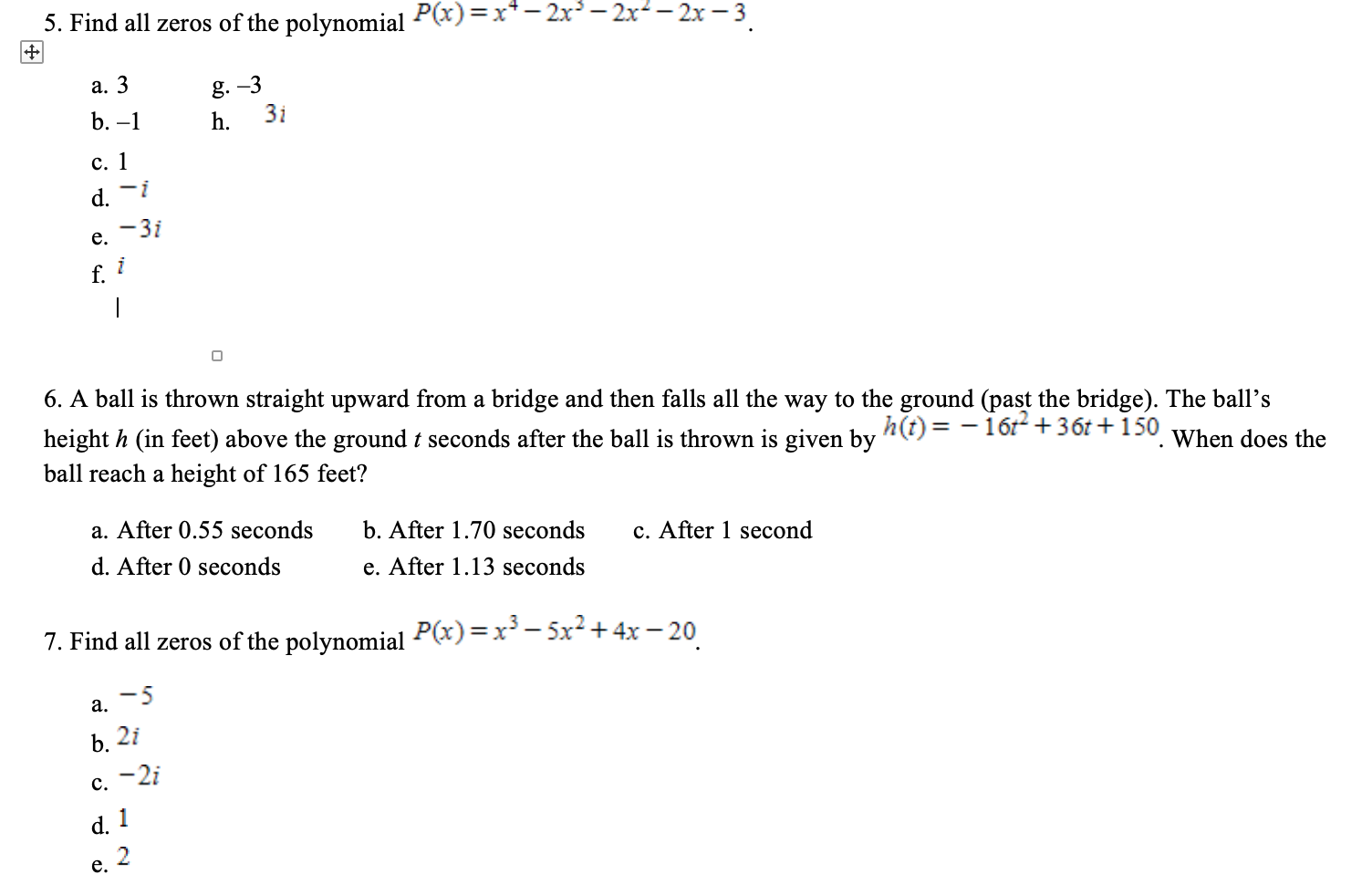
Solved 5 Find All Zeros Of The Polynomial P X X 2x Chegg Com

Finding Zeros Of Polynomials 2 Of 2 Video Khan Academy
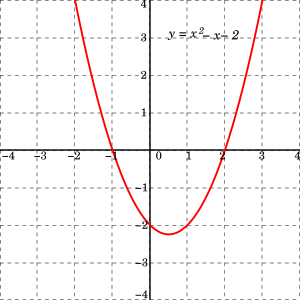
Quadratic Equation Wikipedia
Q Tbn 3aand9gcq6gf25op9dejp5qxofv69ixpoa0t3nh9dd6spopldy2pvo9a Usqp Cau

Polynomials Class 9 Cbse Mathematics Guide Ncert Solutions Math Exercise 2 2 Cbse Guide Ncert Solution
2

Verify Whether The Following Are Zeros Of The Polynomial Indicated Against Them Or Not I Brainly In
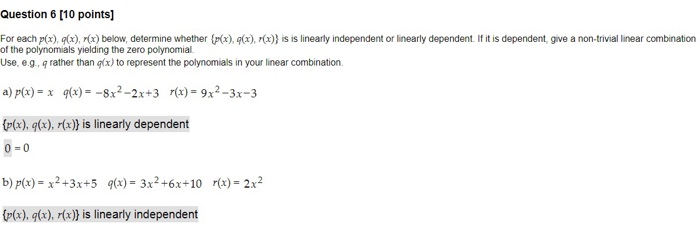
Solved Question 6 10 Points For Each P X X X Below Chegg Com

Verify Whether The Indicated Numbers Are Zeros Of The Polynomials Corresponding To Them In The Following Cases P X X3 6x2 11x 6 X 1 2 3

Example 5 Verify Whether 2 0 Are Zeroes Of Polynomial

Find A Rational Number Between 2 And 3 Verify Whether The Followin

Verify Whether 2 3 And 1 2 Are Zeroes Of The Polynomial P X 2x3 11x2 17x 6 Brainly In
The Zero Of P X 9x 4 Is

Solve Quadratic Equation With Step By Step Math Problem Solver

Polynomials Exercise 2 3 Class 10 Breath Math
Search Q Find The Value Of K If X 1 Is A Factor Of 4x3 2b3x2 4x 2bk Tbm Isch

3 Verify Whether The Following Are Zeroes Of The Polynomial Indicated Against Them Pl 2x

Find The Zeros Of A X2 1 X 1 Quadratic Polynomial And Verify The Relationship Between The Zeros Brainly In

Ex 2 2 3 Verify Whether Following Are Zeroes Of The Ex 2 2
Cbse 9 Math Cbse Polynomials Ncert Solutions

Verify Whether The Following Are Zeroes Of The Polynomial Indicated Against Them P X X 1 X 2 X 1 2
2

Cbse Class 9 Maths Ncert Solution Polynomial Exercise 2 2 Problem 3 Youtube

Class 10 Maths Chapter 2 Ncert Exemplar Solution Part Ii
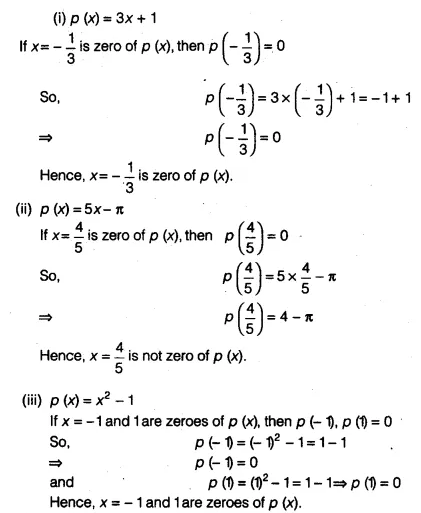
Verify Whether The Following Are Zeroes Of The Polynomial Indicated Against Them Cbse Class 9 Maths Learn Cbse Forum

Polynomial Functions

The Zeroes Of The Polynomial P X X 6 X 5 Are

Quadratic Polynomial 2x 2 3x 1 Has Zeros As A Alpha And Beta Now Form A Quadratic Polynomial Whose Zeros Are 3alpha And 3 Beta

Chapter 2 Polynomials Rd Sharma Solutions For Class 10 Mathematics Cbse Topperlearning

Verify Whether The Following Is Zeroes Of The Polynomial Indicated Against P X 3x 1 X 1 3 2 3 Brainly In

Verify Whether The Values Of X Given In Each Case Are The Zeros Of The Polynomial Or Not 1 Brainly In

3 Verify Whether The Following Are Zeroes Of The Polynomial Indi

Ex 2 4 1 Optional Verify Numbers Are Zeroes Of Cubic Polynomials

Ex 2 2 3 Verify Whether Following Are Zeroes Of The Ex 2 2

Verify Whether The Values Of X Given In Each Case Are The Zeroes Of The Polynomial Or Not Brainly In

Find The Zeros Of The Quadratic Polynomial 8x2 4 And Verify The Relation Between The Zeros And Its Brainly In

Pleaseseetheattachmentbelow Please Kindly Find The Attachment Please See Attached For Reference Below I Have Attached
Cbse 9 Math Ncert Solutions

Verify Whether The Following Are Zeros Of The Polynomial Indicated Against Them Q 3 Iii Iv Youtube

Chapter 2 Polynomials Rd Sharma Solutions For Class 10 Mathematics Cbse Topperlearning

Verify Whether The Value Of X Given In Each Case Are The Zeroes Of The Polynomial Or Not I Want All Brainly In

Verify Whether The Following Are The Zeroes Of The Polynomial Indicated Against Them A P X P Brainly In

Find The Zeroes P X 4x Square 24x 36 Quadratic Polynomial And Verify The Relationship Between The Brainly In

Verify Whether The Following Is Zero Of The Polynomial P X X 1 X 2 And X 1 Brainly In

Zeros Of Polynomials Class 9 Polynomials Basics Class 9 Ex 2 2 Q3 Ncert Youtube

Show That 1 Upon 2 And Minus 3 Upon 2 Are Zero Of The Polynomial 4 X Square 4 X Minus 3 And Also Brainly In

3 Verify Whether The Following Are Zeroes Of The Polynomial Indicated Against Them I Quad

Polynomials Ex 2 2 Que 3 Algebra Class 9th Ncert Maths Edusaral Youtube
Http Www Mpsaz Org Rmhs Staff Esritter Algebra2 Files Ch 1 2 Review Key Pdf

Zeros Of Polynomials Their Graphs Video Khan Academy

Ex 2 2 3 Verify Whether Following Are Zeroes Of The Ex 2 2
Http Abhyudayvidyasthali Edu In Wp Content Uploads 05 Solutions Pdf
Find The Remainder When X4 X3 2x2 X 1 Is Divided By X 1

3 Verify Whether The Following Are Zerocs Of The Polynominl Indicined Arament The N Begin Array L L Text Iii P X 3 X 1
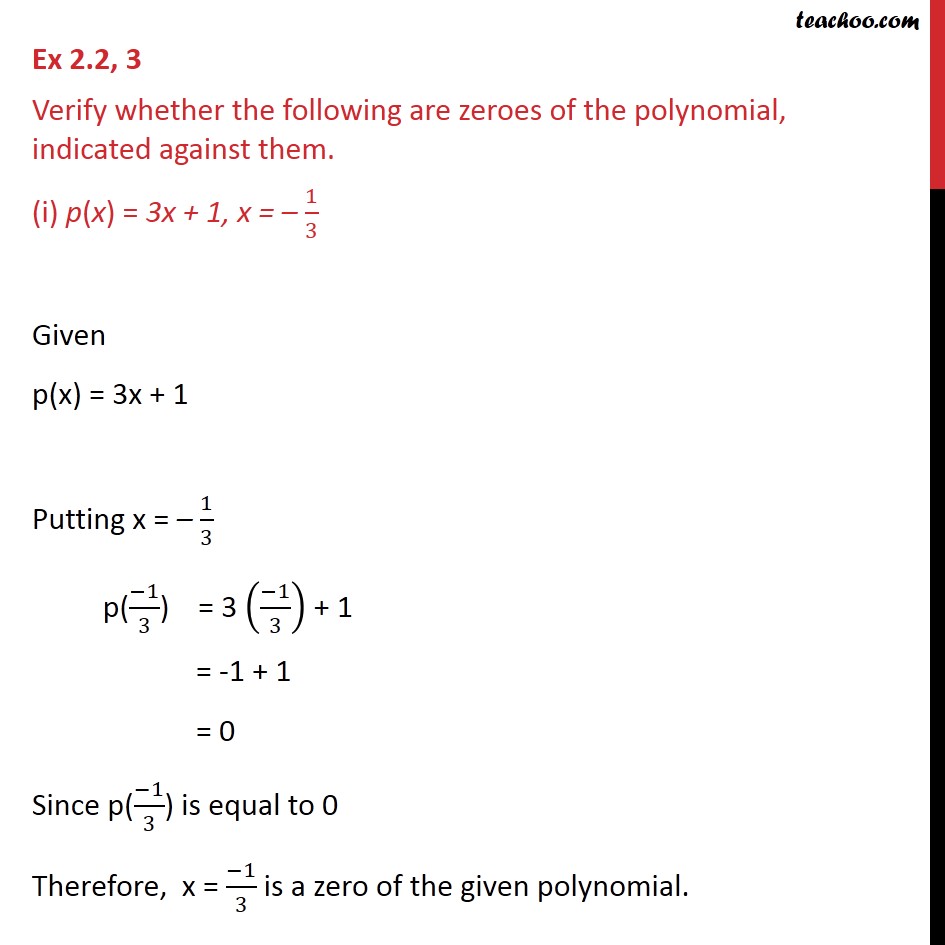
Ex 2 2 3 Verify Whether Following Are Zeroes Of The Ex 2 2

Verify Whether The Followings Are Zeroes Of The Polynomial Indicated Against Then Begin Array Ll Text 1 P X X 2 1 X 1 1 Text Ii P X 2 X 1 X Frac 1 2 Text Iii

Verify Whether The Following Are Zeroes Of The Polynomial Indica

Verify That 3 1 And 1 3 Are The Zeroes Of The Cubic Polynomial P X 3xcube 5xsquare 11x 3 And Brainly In

Verify Whether The Following Are Zeroes Of The Polynomial Indicated Against Them I P X 3x Youtube

3 Verify Whether The Values Of X Given In Each Case Are The Scholr

Inomat Verify Whether The Following Are Zeroes Of The Polynomial Indicated Against Them 1 P

Finding Zeros Of Polynomials 1 Of 2 Video Khan Academy
Verify Whether 2 3 And 1 2 Are The Zeroes Of The Polynomial P X 2x 3 11x 2 17x 6 Sarthaks Econnect Largest Online Education Community
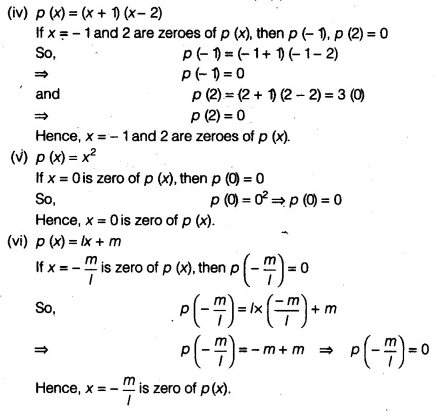
Verify Whether The Following Are Zeroes Of The Polynomial Indicated Against Them Cbse Class 9 Maths Learn Cbse Forum

Verify Whether The Following Are Zero Of The Polynomial Indicated

Ncert Class Ix Polynomials Exercise 2 Question No 3 Youtube
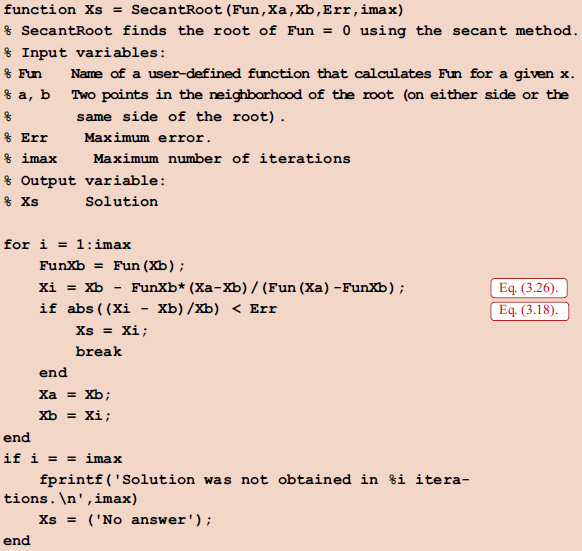
Solved Solve The Following Problems Using The Matlab Environme Chegg Com

Class 9th Ex 2 2 Q 3 I To Iv Polynomials Maths Cbse Ncert Mathsteacher Class Ix Youtube
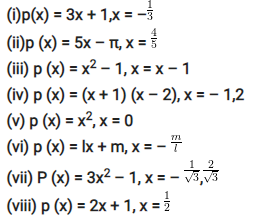
Verify Whether The Following Are Zeroes Of The Polynomial Indicated Against Them Cbse Class 9 Maths Learn Cbse Forum
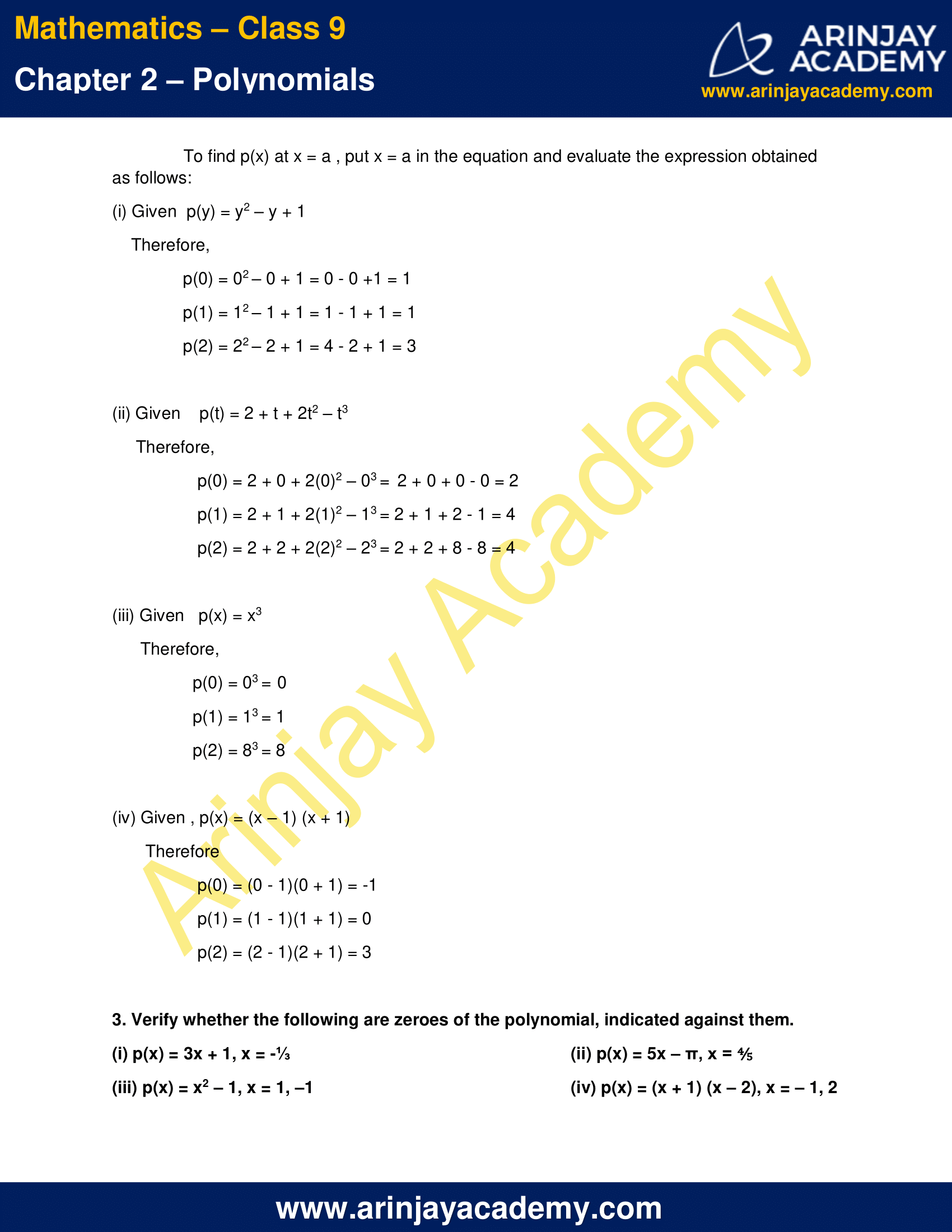
Ncert Solutions For Class 9 Maths Chapter 2 Exercise 2 2 Polynomials

Verify Whether The Following Are Zero Of The Polynomial Indicated

Ncert Solutions For Class 9 Maths Chapter 2 Polynomials Ex 2 2 Cbsetuts Com
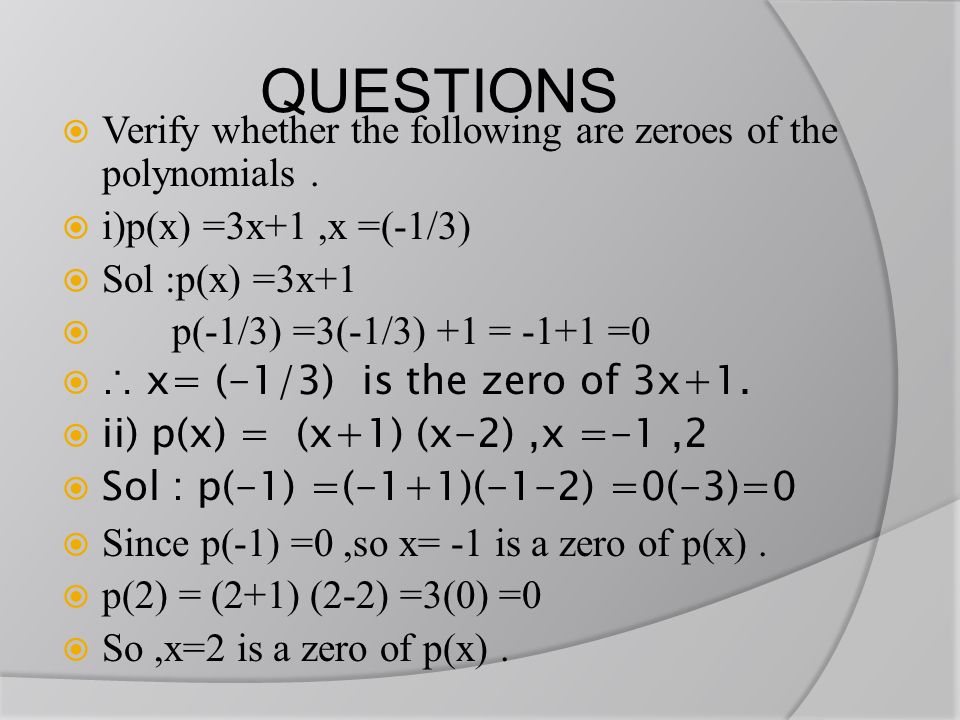
Polynomials Ppt Video Online Download

Check Whether G X X 2 3x 1 Is A Factor Of The Polynomial P X 3x 4 5x 2 7x 2 2x 2 By Dividing P X By G X

Rd Sharma Class 9 Solutions Maths Chapter 6 Factorization Of Polynomials

Ex 2 2 3 Verify Whether Following Are Zeroes Of The Ex 2 2

Andhra Pradesh Ssc Class 10 Solutions For Maths Polynomials Cbse Tuts

4 Find The Zero Of The Polynomial In Each Of The Following Cases

Finding Zeros Of Polynomials Example 2 Video Khan Academy

Ex 2 4 1 Optional Verify Numbers Are Zeroes Of Cubic Polynomials
Cbse 10 Math Cbse Arithmetic Progression Ncert Solutions

Ncert Solutions For Class 9 Maths Chapter 2 Polynomials

Hgg Ortmalon35verify Whether The Following Are Zeroes Of The

Zeroes Of Polynomial Functions Boundless Algebra

Find The Zeros Of The Quadratic Polynomial X Square 2 X Minus 8 And Verify The Relationship Between Brainly In

Hgg Ortmalon35verify Whether The Following Are Zeroes Of The
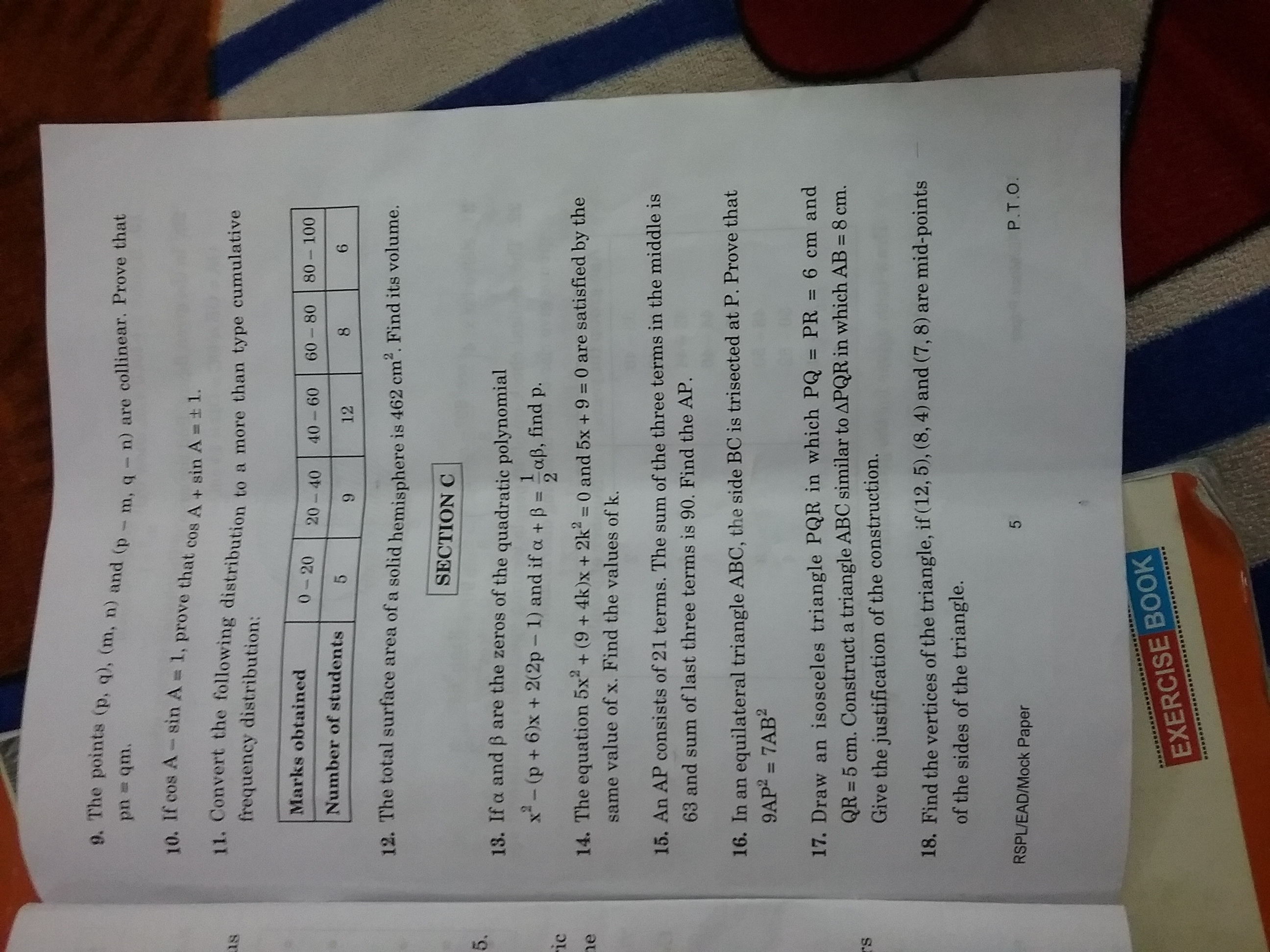
Zeros Of The Polynomial Questions And Answers Topperlearning

Zeros Of Polynomials Matching Equation To Graph Video Khan Academy
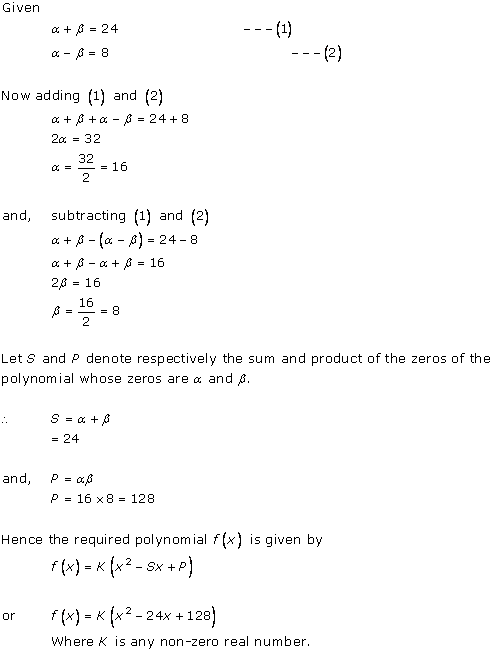
Chapter 2 Polynomials Rd Sharma Solutions For Class 10 Mathematics Cbse Topperlearning
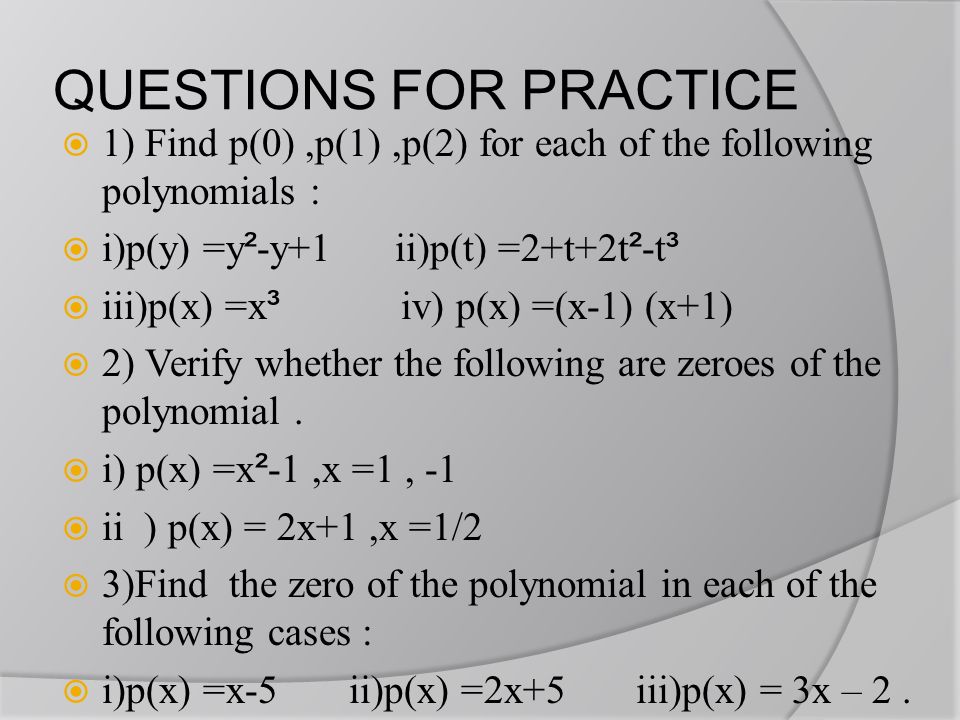
Polynomials Ppt Video Online Download
Cbse 9 Math Cbse Polynomials Ncert Solutions

B X 1find P 0 P 1 And P 2 For Each Of The Following Polyno

Ex 2 2 4 Find The Zero Of The Polynomial In Each Of Ex 2 2

Verify Whether 2 1 Are The Zeroes Of The Cubic Polynomial Scholr

Polynomials Exercise 2 3 Class 10 Breath Math
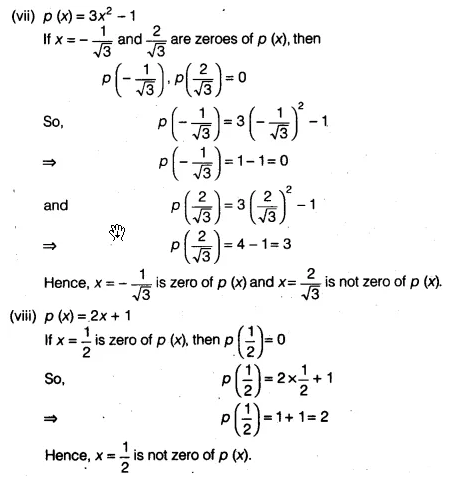
Verify Whether The Following Are Zeroes Of The Polynomial Indicated Against Them Cbse Class 9 Maths Learn Cbse Forum

Ex 2 2 3 Verify Whether Following Are Zeroes Of The Ex 2 2

3 Verify Whether The Following Are Zeroes Of The Polynomial Indicated Against Them N 1 Quad P X 3 X 1 X Frac 1 3 N Ii P X 5 X Pi X Frac 4 5 N Iii P X X 2 1 X 1 1 N Iv P X X 1 X 2 X 1 2 N
Www Lcps Org Cms Lib Va Centricity Domain Afm unit 3 day 3 key Pdf




